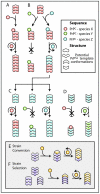Prion diseases and their biochemical mechanisms
- PMID: 19239250
- PMCID: PMC2805067
- DOI: 10.1021/bi900108v
Prion diseases and their biochemical mechanisms
Abstract
Prion diseases, also known as the transmissible spongiform encephalopathies (TSEs), are a group of fatal neurodegenerative disorders that affect humans and animals. These diseases are intimately associated with conformational conversion of the cellular prion protein, PrP(C), into an oligomeric beta-sheet-rich form, PrP(Sc). A growing number of observations support the once heretical hypothesis that transmission of TSE diseases does not require nucleic acids and that PrP(Sc) alone can act as an infectious agent. The view that misfolded proteins can be infectious is also supported by recent findings regarding prion phenomena in yeast and other fungi. One of the most intriguing facets of prions is their ability to form different strains, leading to distinct phenotypes of TSE diseases. Within the context of the "protein-only" model, prion strains are believed to be encoded in distinct conformations of misfolded prion protein aggregates. In this review, we describe recent advances in biochemical aspects of prion research, with a special focus on the mechanism of conversion of prion protein to the pathogenic form(s), the emerging structural knowledge of fungal and mammalian prions, and our rapidly growing understanding of the molecular basis of prion strains and their relation to barriers of interspecies transmissibility.
Figures



References
-
- Prusiner SB. Novel proteinaceous infectious particles cause scrapie. Science. 1982;216:136–144. - PubMed
-
- Caughey B, Chesebro B. Transmissible spongiform encephalopathies and prion protein interconversions. Adv Virus Res. 2001;56:277–311. - PubMed
-
- Collinge J. Prion diseases of humans and animals: their causes and molecular basis. Annu Rev Neurosci. 2001;24:519–550. - PubMed
-
- Aguzzi A, Polymenidou M. Mammalian prion biology: one century of evolving concepts. Cell. 2004;116:313–327. - PubMed
Publication types
MeSH terms
Substances
Grants and funding
LinkOut - more resources
Full Text Sources
Other Literature Sources
Molecular Biology Databases
Research Materials

